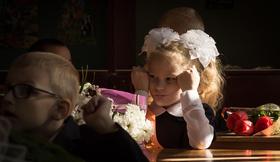Since the educational reform movements of the 1970s, significant efforts have been made to promote girls’ improvement within the education system. Unfortunately, instead of creating an equal learning environment, classroom teaching styles heavily favored female students at the cost of the success of their male cohorts. Now, boys are an average of 1.5 years behind girls in reading ability, a gap that persists through college and even upon entering the workforce. Extensive research is being conducted to identify characteristics of positive learning environments for boys and methods for introducing those findings into schools across America.
Active Classroom Environment
The environment a teacher establishes in the classroom is a significant contributor to how effectively students learn. Traditional classroom environments, in which all children are expected to sit quietly while following along with the teacher, presume that all children learn similarly. Those with trouble with the format may fall behind despite their learning capacity. Additionally, this isn’t necessarily a structured environment nor an engaging one that will foster a passion for learning.
This video offers some reasons why your son should attend an all-boys school.
To engage all students, teachers should instead employ an active learning environment. This type of setting stimulates self-motivated learning within a flexible yet disciplined atmosphere. By teaching students learning strategies (a written record of assignments, note-taking strategies, time management techniques, and study methods), educators teach students how to learn or “the process of learning,” and students become empowered to pursue knowledge more eagerly and successfully. An active classroom also demands that the students are presented with choices. By having the freedom to choose between projects, students are more willing to take on the challenges that learning entails. By having a say in their education, students not only take on the responsibility of learning but also have a more meaningful and lasting experience.
In an active learning classroom, students learn more about themselves and what subjects or types of work motivate them. They also gain a deeper understanding of the people around them. By seeing what their classmates are interested in, they learn to appreciate these interests and develop compassion for the needs of others. In having an active voice in the classroom, students will feel more responsible for their learning and behavior, mainly if they help create a classroom constitution or discuss appropriate classroom behavior. Instead of feeling helpless and distracted in the classroom, students become willing participants and are more able to exercise self-discipline.
“Guide on the Side” Mentality
Traditional classrooms are structured to follow a teacher through exercises, skill acquisition, and learning curriculum-mandated materials. In this model, sometimes called “sage on the stage,” all responsibility for the children’s learning is placed squarely on the teacher, and students are more or less passive recipients of knowledge. In contrast, Grand River Academy has created the “guide on the side” model, challenging students to take a highly active role in their education. In this type of classroom environment, the curriculum is based on students' questions on a given topic, and students work together to answer these questions. Students experience a marked shift in how they interact, behave, and focus within this structure. Because the students essentially design the classes, the curriculum fits all students' learning preferences, and stereotypical classroom behaviors disappear. Curiosity and inquisitiveness are encouraged and fostered in this environment, making them lifelong learners.
This video offers an overview of McCallie School in Chattanooga, Tennessee.
Despite the shift in responsibilities, the role of the teacher remains critical in the classroom. While students are eager learners, most have not experienced the extent of self-organization, patience, and collaboration required by this classroom format. To keep the class moving forward, teachers act as a resource for leadership, guidance, and information. They also participate as group members, posing their questions for students to investigate their way; teachers still have a guiding hand in the curriculum while also creating an environment of active learning and engagement.
Collaboration and Creativity
A significant component of applying a “guide on the side” philosophy is encouraging collaboration among students and allowing them the freedom to work and solve problems creatively. Classroom exercises often require that students sit quietly and complete work individually before sharing. Relying on this style can create dead time, during which attention drifts, and students are no longer engaged with their work. While independent study is appropriate at certain times, the classroom allows students to interact with peers and educators to cultivate a deeper understanding of the material. Instead of using classroom time for collaboration, children can help each other with joint problems, develop ideas through peer contributions, and inspire one another with questions about the material. In a creative and flexible environment, students can explore new areas, coming to a deeper understanding of new material through the shared exploration of personal questions.
Emotional Development
Even today, society imposes the “BoyCode,” as Dr. William Pollock identifies it, onto boys from a very young age. This is the idea that masculinity demands that men don’t complain about hardship but rather act “tough” in the face of it. In the classroom, this attitude translates into a familiar scenario: when boys have trouble and can’t keep pace with the curriculum, they don’t seek help from teachers — they act out. Teachers reacting to this behavior will often approach the issue as a disciplinary problem rather than a scholastic problem. As this situation continues to repeat itself, frustration and depression begin to characterize the child’s experience at school. Tragically, Pollock also notes that between the ages of 10 and 19, boys are four times more likely to take their lives than girls are, and over the last 20 years, these figures have increased 300%. Fortunately, schools have incredible assets for promoting the emotional development of boys: their own staff. One of the most critical factors in children's emotional security at school is having a teacher, administrator, or adult with some authority to whom they can go and speak openly, non-punitively. Forming “shame-free” connections between adults and students helps boys deal with feelings of anxiety and depression as they navigate life at school.
This video offers an overview of Woodberry Forest School, Woodberry Forest, Virginia.
Research demonstrates that intelligent, energetic boys are left behind within the current education system. Unsympathetic critics may point to men’s success in the workforce to justify inaction. However, an uneducated, low-earning male population will not contribute to eradicating later gender gaps, and such an attitude of retaliation unfairly sacrifices the development and futures of boys across America. Ultimately, to ensure that young men have a fair chance at a productive, fulfilling life, teachers must learn ways of creating equal-opportunity classrooms. When teachers adopt a student-centered approach to education, boys are free to express themselves, explore material that engages them, and grow as individuals.
Grand River Academy is an all-boys private school located in a small rural community near Cleveland, Ohio. The school’s mission is to engage young men and motivate them to achieve scholastic, emotional, and physical growth. Through a structured yet flexible and adaptable teaching approach, Grand River Academy prides itself on helping students attain academic success, even when public schools fail to do so. For more information about how private school education can benefit high school boys, contact GRA today.
Questions? Contact us via Facebook. @boardingschoolreview













